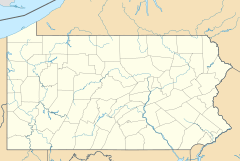District of West Augusta facts for kids
The District of West Augusta was a special area in Colonial Virginia that existed for a short time, from 1774 to 1776. It covered a big part of what we now know as northern West Virginia and southwestern Pennsylvania.
Contents
How West Augusta Came to Be
|
Pennsylvania Historical Marker
|
|
| Location | U.S. 40, 3 miles SW of Washington, Pennsylvania |
|---|---|
| Coordinates | 40°09′04″N 80°19′03″W / 40.15099°N 80.31753°W |
| PHMC dedicated | May 28, 1947 |
Before the Colony of Virginia and the Province of Pennsylvania agreed on their exact borders, both claimed a large area in what is now southwestern Pennsylvania. This was before the Mason-Dixon line was extended westward.
After the French and Indian War (1754–1763), not many people lived in this area. Neither colony tried to set up a local government there until the early 1770s. Virginia managed the region as part of its Augusta County, Virginia. Pennsylvania later created Westmoreland County, with its main town at Hannastown. These two claims overlapped.
Virginia's governor, Lord Dunmore, went to Pittsburgh. Virginia believed Pittsburgh was part of its land. In 1774, Lord Dunmore appointed government officials there under Virginia's rules. That same year, the Virginia assembly separated the western part of Augusta County. This new area was named the District of West Augusta.
What Were Its Borders?
The District of West Augusta was a large territory. It included all the land north of a certain line and west of Pennsylvania and Maryland.
- The boundary started in the Allegheny Mountains.
- It followed mountain ridges and rivers like the Monongahela.
- It went up the Monongahela River and its west fork to Bingerman's Creek.
- From there, it went to Middle Island Creek, which flows into the Ohio River.
- All the land to the north of this line and west of Pennsylvania and Maryland was part of the District of West Augusta.
A Time of Disagreement
For several years, there was a lot of tension. Officials from Virginia would arrest officials from Pennsylvania, and vice versa. Each state tried to stop settlers from the other state from moving into the disputed area.
The government of West Augusta was first run from Fort Dunmore (which is now Pittsburgh). Later, the main office moved to Augusta Town in what is now Washington County, Pennsylvania. In August 1776, Augusta Town became the site of the first court held west of the Monongahela River.
The District Is Divided
In 1776, the District of West Augusta was divided into three new counties:
Ohio County covered most of the western part of the district, along the Ohio River. This included parts of what are now Washington and Greene Counties in Pennsylvania.
Monongalia County covered much of what is now north-central West Virginia. It also included parts of what are now Washington, Greene, and Fayette Counties in Pennsylvania.
Yohogania County was a large area in what is now southwestern Pennsylvania. It included all of what is now Westmoreland County, Pennsylvania. It also covered parts of present-day Washington, Fayette, Allegheny, and Beaver counties. Plus, it included Hancock County, West Virginia and the northern part of Brooke County, West Virginia.
The Border Is Settled
In 1780, the argument over the border between Virginia and Pennsylvania finally ended. Both sides agreed to extend the Mason-Dixon line westward from Maryland. This line became the current western border of Pennsylvania.
Most of Yohogania County became part of Pennsylvania. That land was divided between Westmoreland County and the newly formed Washington County in Pennsylvania. Later, Beaver and Allegheny counties were created from these lands. The small part of Yohogania that stayed in Virginia was added to Ohio County. This area is now divided between Brooke County and Hancock County in West Virginia. These counties were later formed from Ohio County, at the very northern tip of West Virginia's Northern Panhandle.



